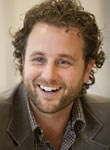Lies, buys and revolutions: Social media -- revered or reviled -- is here to stay
By George Lowery

The explosion of social media is allowing social scientists to extract meaningful "knowledge" from vast stores of data recording seemingly trivial observations, said Jeff Hancock, associate professor of communication, to an alumni audience Oct. 21 during Trustee-Council Weekend.
"If you were to condense a typical American's day to one hour, 17 minutes of that hour would be spent using social media," Hancock said. "But is there anything of value on there? Or is it truly a massive waste on a gigantic scale of humanity's time and attention?"
To illustrate his contention that there's value in all those posts reporting on daily minutiae, Hancock cited the example of corn traders who, pre-social media, physically drove to fields to observe their wetness or dryness. Post-social media, a trader noticed farmers tweeting to each other.
"This analyst realized he was getting microdata tagged to specific places; he was getting inside the farms rather than driving by them. He collected hundreds of the farmers' tweets every day and generated knowledge and made a lot of money" by buying or selling corn based on freely available "insider" knowledge.
Hancock showed a chart of Twitter activity on 2.6 million tweets mentioning the word "Libya," weighted for positive or negative words used during its current revolution. "We can predict with about 85 percent accuracy when a massive protest is about to happen the next day based on certain words reaching a certain level," he said.
But how much of the information flooding through Twitter and Facebook is true? If data is full of lies, it undermines the data's worth to researchers. Hancock, who has studied online deception, cited people using Facebook pages to seek donations for supposedly ill children or for themselves, and that the "space" of online communication would seem to lend itself to untruths.
In analyses of text messages, "We're finding that a lot of the lies are about buffering oneself from the constant availability that these devices make us subject to," such as "I'm on my way!"
"We call them 'butler lies'; we start using the phone and the ambiguity that comes from that," he said. "Face to face, we can't do that sort of deception."
Hancock had alumni participate in an impromptu experiment: How many of their last 10 text messages contained a lie? To those without smart phones he asked: Since returning to campus, have you told a lie? Hancock said his research shows about one in 10 text messages is deceptive.
"We actually find that texting and email are more honest than face-to-face interactions," Hancock said. "Guess where people lie the most: on the telephone." But plenty of lies, paid for by competitors, are turning up in online reviews that people rely on to plan trips, for example.
For in-person communication, most cultures look a person in the eye to gauge if he or she is lying. Big mistake. Forty-five years of research prove that "humans cannot rely at all on eyes for deception," Hancock said. "The average deception detection rate is 54 percent." Reliance on facts, now easier to check via the Internet than ever before, he said, is the best way to determine truth.
"Social media is not going away," Hancock said. "We can revile it ... but I do believe as a scientist and as a dad that there is some knowledge and some use that we can get out of it."
Media Contact
Get Cornell news delivered right to your inbox.
Subscribe